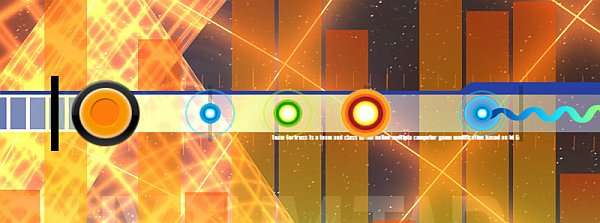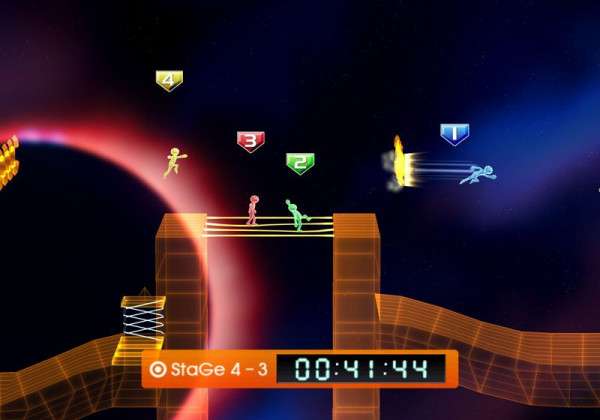Let’s Tap Wii Review

To play a game simply by tapping on a box has to be seen as an accomplishment. We have already done tapping on a screen, waving a remote about, and the whole buttons thing is now decades old. However, simply tapping on a box is a rather clever, interesting, and new fangled way to approach things. If you have not been keeping up to date with the game, and you are already a bit lost due to my introductory ramblings, then it is best to take a step back to explain things.
Let’s Tap is a new game from Yuji Naka, who is most famous for the creation of Sonic the Hedgehog – and will continue to be until the end of time. Back in 2006 he set up a new studio called Prope, with some small financial help from Sega. The studio rose from the mindset of creating games with a unique graphical style that can simultaneously appeal to kids and adults alike. Now, a little bit over two years on, Let’s Tap is the first game out their doors, and for the most part it lives up to the initial promise.
The game is played by placing the Wiimote faced down on the box the game came in (any other ridged cardboard box will also work to be honest). Once positioned, the accelerometer in the Wiimote is able to recognize when you make a light tap or a heavy tap on the box. Furthermore it is also able to recognize the frequency of the taps.
Using these simplistic inputs, there are 5 minigames on show to amuse. Top of the billing is Tap Runner, which pits you against 4 other characters in a race – with CPU taking control of some characters if there are not 4 people available. The game works akin to the Track & Field games of old, where you had to quickly tap buttons to make your character run.
However, in Let’s Tap this is simplified further, tasking you getting a good two-handed tapping rhythm going on your box to speed your character up – with a satisfying whoosh noise kicking in when you reach top speed. There is a large selection of tracks on show, with various obstacles placed throughout to keep things interesting. Some challenge you to walk across tightropes (which seems to work best with a slow tapping rhythm), while others have you jumping hurdles (which is done with a strong tap on the box). As you work your way though the track available, unlocking more as you go, they get longer and more elaborate, with multiple routes becoming available.
Without a doubt my favourite mode was Rhythm Tap, a music rhythm game with an interface reminiscent of the Donkey Konga games on the GameCube. However, that is where the similarity ends, as this time there little to no variation in how you tap to the beat. In Donkey Konga you could hit notes with your right of left hand, or at times both.
However, due to the tapping interface being so simplistic in Let’s Tap, you simply just tap every note in the same way. The game won’t even register if it is a stern or soft tap, like it does in some of the other minigames. Nevertheless, the songs on show are catchy, with an eclectic mix of J-Pop and high tempo dance tunes on show in the 22 available. It certainly won’t challenge the big names in the rhythm genre, but it is fun in short bursts.
Next up is Silent Blocks. It is best described as a dumbed down version Jenga, in which you faced with an unstable tower made of blocks, It is then up to you to take the tower apart piece by piece without knock down a prize sitting atop. You remove the blocks by choosing which one you want to move, and then you chose what direction you want to pull it out. You then use different ferocity of taping to nudge the block out, hopefully without causing too much damage to the surrounding blocks. Furthermore, as with all the other games this gets more and more complicated the more you play.
Then there is Bubble Voyager, which to me left a bit like the Rare classic Jetpac. As with all the other minigames you control the character by tapping – which should be second nature by now. The quicker you tap the more bubbles he will release, and he floats up. Tapping slower means he will release less bubbles, and glide down. Using this control method you have to move around levels, collecting various stars, dodging mines, and collecting missiles you can shoot at rocks.
Finally, there is a mode called Visualizer. There are no games in this mode per se, instead you are offered a selection of freestyle options to make ripples in water, paint pictures, and shoot fireworks into the sky which are all controlled by selection of various taps you make. It’s all a bit artsy, and could appeal to some, but could in turn bore others to death.
All in all, Let’s Tap is a top-notch madcap game, and quintessentially Japanese in its wacky approach. It is a very simple idea, but it is presented with enough pizazz and style to make it feel worthwhile. However, the fact that it only has four playable minigames, albeit with many variations, does seem a bit stingy when Sega are asking full price for the game.
Nevertheless, it is possible the game could become a cult hit down the line, much like what happen with the Ouendan series a few years back, as there is certainly enough interesting content on show to pique the interest of a few people in the west. At the very least, the game’s main theme is one of the most catchy heard in years, that has to be worth a few plaudits.
Import friendliness: When you first put Let’s Tap into your Wii you’ll be hit with a fair few pages with of Japanese text, as the game runs you though a brief tutorial before it lets you play. Basically, these screens inform you about how the game works. How you tap, to move through the menus, and how you double tap to select. Luckily, all of this text is accompanied by an animated graphic to help you figure out how to play the game. Thankfully, once you get past this introduction, almost all the other menus have enough English in them to make the game very easy to navigate.



